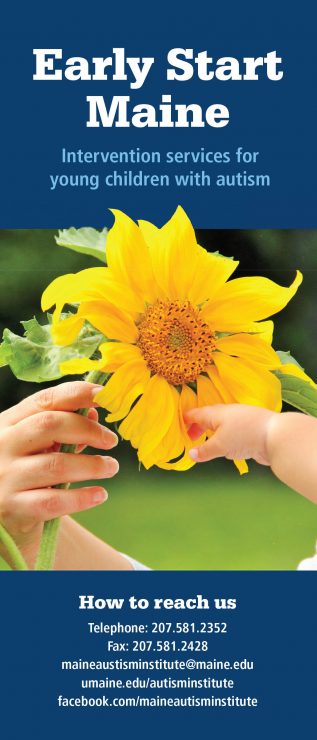
Getting Started: Foundations of Early Start Maine and Integrating the Early Start Denver Model (ESDM) with
Routines-Based Early Intervention in Maine
Module 1: Early Start Maine (ESM)
Upon completing this module you will be able to describe:
- Why the Early Start Denver Model (ESDM) was chosen to deliver services for young children with ASD and their families for ESM
- How early brain research supports the ESDM model
- The importance of including families
Activities to support your learning:
Read the following:
- Preface and Chapter 1 in the ESDM Manual
- Visit Early Start Maine on the MAIER web site
- Review the Early Start Maine brochure
- Read: Early Start Denver Model Overview [PDF]
Why ESDM for Maine?
In order to provide effective learning experiences for young children with ASD, we have to enhance learning opportunities in routines everywhere and throughout the daily routine.
Early Start Maine is a….
- developmental,
- behavioral,
- relationship, and
- play-based
intervention that is EMBEDDED within the state’s IDEA Part C service delivery model.
ESDM was chosen because:
- There is a direct connection with current EI practices and initiatives in Maine.
- It is an effective model for working with young children with ASD by scientific research.
- It is designed to promote language, learning, and engagement for young children 12-48 months with ASD.
- Provides strong family involvement
- Is delivered within play-based, relationship-focused, everyday routines in the natural environment.
ESDM is an evidence-based practice backed by scientific research
- Demonstrated effectiveness
- Objective data
- Most likely to result in improvements
For more information on ESDM research, read these articles:
Community Dissemination of the Early Start Denver Model: Implications for Science and Practice
Randomized, Controlled Trial of an Intervention for Toddlers With Autism: The Early Start Denver Model
ESDM addresses all areas of development through:
- Behavior-based teaching strategies
- Interpersonal exchange
- Positive affect
- Shared engagement
- Adult responsiveness
- Increased sensitivity to child cues
- Increased understanding of verbal and nonverbal communication skills
In addition, ESDM is relationship-based and is grounded in these principles:
- Development is an interpersonal process.

- Quality of relationships mediate development.
- Quality of relationships = positive affect, reciprocity, adult sensitivity, responsiveness.
- Naturalistic teaching approaches.
Importance of a Relationship-Based Approach to Early Intervention
Infants and toddlers are experiential, hands-on learners. The quality of relationships with caregivers and other adults significantly influences their learning. Research has firmly established that the learning and development of infants and toddlers takes place within the context of relationships and is critically affected by the quality of those relationships.
All types of relationships are critical for effective early intervention: within families, parent-practitioner, practitioner-practitioner, supervisor-practitioner, as well as parent-infant relationships. The ESDM Curriculum has a strong emphasis on building strong relationships through sensory social routines and imitation activities.
And….parents are at the helm

* Supporting relationships = supporting families.
*Parents’ preferences and priorities guide the team.
*Preparing parents for a lifetime of decision-making and advocacy.
*Autism is a social disorder: relationships with the family must be at the helm of intervention.
In summary, “Early Start Denver Model strives to strengthen the reward value of social interaction. We strive to increase the child’s repertoire of social-communication skills. We want to increase their learning rates if their learning rates are below average and we want to prevent these experiential alterations in neural and psychological development that can come from not being a part of the social communicative framework of learning during the all-important infant/toddler preschool-learning period.” (Sally Rogers, 2017)
 And in a nutshell~
And in a nutshell~
Elevator Speech: This link will bring you to a document that was developed by MAIER’s ESM Team as a way to describe the ESM Program simply and succinctly.
Module 1 Reflection: What I Learned?
Describe your understanding and knowledge of each of the following:
- How does early brain research support the ESDM model?
- Why was ESDM chosen as the model to meet the needs of young children with autism and their families?
- How does the research support the use of this model?
- What is the importance of including families in the implementation of ESDM?
- I would like more information about ….
When you have completed this module, please send your reflection to your instructor.

